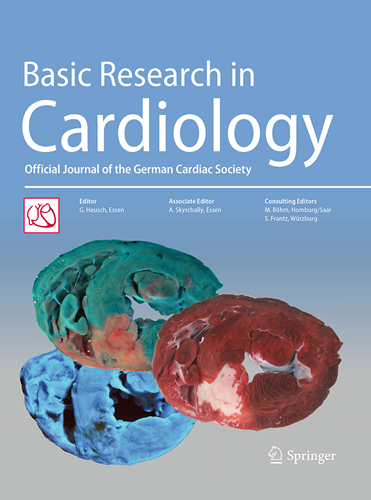Effects of SGLT2 inhibitors on ion channels in heart failure: focus on the endothelium.
IF 8
1区 医学
Q1 CARDIAC & CARDIOVASCULAR SYSTEMS
引用次数: 0
Abstract
Heart failure (HF) is a life-threatening cardiovascular disease associated with high mortality, diminished quality of life, and a significant economic burden on both patients and society. The pathogenesis of HF is closely related to the endothelium, where endothelial ion channels play an important role in regulating intracellular Ca2+ signals. These ion channels are essential to maintain vascular function, including endothelium-dependent vascular tone, inflammation response, and oxidative stress. Sodium-glucose cotransporter 2 inhibitors (SGLT2i) have shown promising cardiovascular benefits in HF patients, reducing mortality risk and hospitalization in several large clinical trials. Clinical and preclinical studies indicate that the cardioprotective effects of SGLT2i in HF are mediated by endothelial nitric oxide (NO) pathways, as well as by reducing inflammation and reactive oxygen species in cardiac endothelial cells. Additionally, SGLT2i may confer endothelial protection by lowering intracellular Ca2+ level through the inhibition of sodium-hydrogen exchanger 1 (NHE1) and sodium-calcium exchanger (NCX) in endothelial cells. In this review, we discuss present knowledge regarding the expression and role of Ca2+-related ion channels in endothelial cells in HF, focusing on the effects of SGLT2i on endothelial NHE1, NCX as well as on vascular tone.SGLT2抑制剂对心力衰竭离子通道的影响:以内皮细胞为重点。
心力衰竭(HF)是一种危及生命的心血管疾病,与高死亡率、生活质量下降以及患者和社会的重大经济负担相关。HF的发病机制与内皮密切相关,内皮离子通道在调节细胞内Ca2+信号中起重要作用。这些离子通道对于维持血管功能至关重要,包括内皮依赖性血管张力、炎症反应和氧化应激。在几项大型临床试验中,钠-葡萄糖共转运蛋白2抑制剂(SGLT2i)已显示出对心衰患者心血管的潜在益处,可降低死亡风险和住院率。临床和临床前研究表明,SGLT2i在HF中的心脏保护作用是通过内皮一氧化氮(NO)途径以及减少心脏内皮细胞的炎症和活性氧介导的。此外,SGLT2i可能通过抑制内皮细胞中的钠-氢交换器1 (NHE1)和钠-钙交换器(NCX)来降低细胞内Ca2+水平,从而赋予内皮保护。在这篇综述中,我们讨论了目前关于心肌梗死内皮细胞中Ca2+相关离子通道的表达和作用的知识,重点讨论了SGLT2i对内皮细胞NHE1、NCX以及血管张力的影响。
本文章由计算机程序翻译,如有差异,请以英文原文为准。
求助全文
约1分钟内获得全文
求助全文
来源期刊

Basic Research in Cardiology
医学-心血管系统
CiteScore
16.30
自引率
5.30%
发文量
54
审稿时长
6-12 weeks
期刊介绍:
Basic Research in Cardiology is an international journal for cardiovascular research. It provides a forum for original and review articles related to experimental cardiology that meet its stringent scientific standards.
Basic Research in Cardiology regularly receives articles from the fields of
- Molecular and Cellular Biology
- Biochemistry
- Biophysics
- Pharmacology
- Physiology and Pathology
- Clinical Cardiology
 求助内容:
求助内容: 应助结果提醒方式:
应助结果提醒方式:


